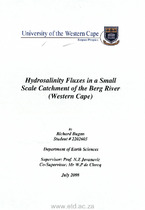Hydrosalinity Fluxes in a Small Scale Catchment of the Berg River (Western Cape)
Abstract
The occurrence of dryland salinity is widespread throughout semi-arid regions of the world. The sources of salts may be either rock weathering or rain deposition. Clearing of natural scrubland to make way for cultivated crops and pastures may also change the water balance, trigger salt mobilization and increase the salinity of water resources. These processes are suspected to be the main cause for salinization of the Berg river catchment (Western Cape). The objective of this study was to determine the hydrosalinity fluxes associated with overland and subsurface (vadose zone) flow for different soils and land uses. For this purpose, the following data were collected during 2005 and 2006 in a typical small scale catchment located near the town of Riebeeck-Wes: weather data, hydrological and water quality measurements, soil water contents and chemistry, and vegetation growth. The area is characterized by a Mediterranean climate receiving winter rainfall of approximately 300 mm a-I. The chemical speciation of water and soil in the catchment is conservative, with Na+ and cr being the dominant ions. The results of the monitoring indicated that uncultivated (bare) soil produced more runoff and higher salinity compared to vegetated land. Overland flow varied between 5 and 17% of rainfall, mobilizing up to 23.55 g m-2 of salts during 2006, depending on soil properties, slopes, rainfall intensity and duration, and antecedent moisture conditions. Due to the typical low intensity of rainfall, the fluxes of salts during individual runoff events were steady. Soil water and salt contents varied seasonally. Fluctuations in salinity due to local processes were evident on a smaller scale at a catchment scale. Subsurface fluxes of water and salts were estimated with the HYDRUS-2D model. The model showed that approximately 700 g m-I of salts were mobilized by subsurface flow along a 22 m long soil profile.
Management practices at farm scale are required in order to reduce salt mobilization and salinization at catchment scale.

